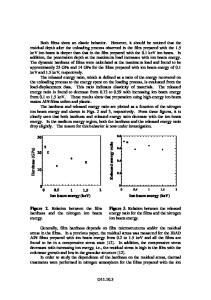Texture and Nano Mechanical Properties of YSZ Electrolyte Thin Films Prepared by CCVD and PLD
- PDF / 658,491 Bytes
- 6 Pages / 612 x 792 pts (letter) Page_size
- 44 Downloads / 334 Views
U6.10.1
Texture and Nano Mechanical Properties of YSZ Electrolyte Thin Films Prepared by CCVD and PLD Z. Xu, C. Waters, X. Wang, N. Sudhir, S. Yarmolenko, and J. Sankar NSF Center for Advanced Materials and Smart Structures North Carolina A&T State University, Greensboro, NC 27411 ABSTRACT Composite thin films of yttria stabilized zirconia (YSZ) and alumina (Al2O3) have been synthesized using liquid fuel combustion chemical vapor deposition (CCVD) and pulsed laser deposition (PLD) in the NSF Center for Advanced Materials and Smart Structures (CAMSS) at North Carolina A&T State University. With the CCVD technique, addition of alumina was realized by adding the designated amount of aluminum-organic in the reagent solution; while with PLD, doping of alumina in YSZ was accomplished by alternative ablations of an YSZ target and an alumina target. Variations in morphology, surface roughness and nano-mechanical properties of the composite thin films of Al2O3 /YSZ were characterized. Crystal size of the films processed by CCVD was much larger than that processed by PLD; surface roughness follows the similar tendency. Upon high-temperature annealing, crystals in the PLD processed thin films grew up to 300 nm. The effect of Al2O3 in YSZ thin films on their nano-mechanical properties was dependent on the film deposition techniques in our research. For the films deposited by CCVD, addition of Al2O3 improved the nano hardness and elastic modulus of YSZ thin films, while a decline was observed in the mechanical properties of the films deposited by PLD.
INTRODUCTION YSZ is the most widely used electrolyte material for solid oxide fuel cells and other electrochemical devices. Thin film YSZ electrolyte has received great interest since the current path in the relatively low-conductive electrolyte is minimized, which causes the working efficiency of the devices, e.g. fuel cells, to be improved. However, the mechanical strength of the YSZ is low, which may lead to cracks and damage of the electrolyte layer upon cycles of heating and cooling in the operation of fuel cells. The addition of Al2O3 had been reported to improve the strength of both 3 mol. % yttria partially stabilized zirconia (Y-TZP) and YSZ. The addition of Al2O3 was also reported to improve the sintering behavior [1], electrical properties [2,3] of YSZ. For example, Mori et al. reported that the addition of Al2O3 up to 20 wt.% in 8 mol.% Y2O3-ZrO2 (8YSZ) improved the bending strength of the composite [4]. On the other hand, improvements in ion-conductivity of YSZ electrolyte is of great importance. The electrical conductivity of 8YSZ showed a maximum at about 1 wt.% addition of Al2O3 [5]. The role of Al2O3 in enhancing the electrical conductivity of cubic YSZ is known as the scavenging effect by eliminating the grain boundary impurities, mainly SiO2 and Na2O [6-8]. In this paper, composite thin films of YSZ-Al2O3 synthesized using CCVD and PLD will be reported. The purpose is to understand the effects of the addition of Al2O3 on the microstructure, mechanical propertie
Data Loading...











